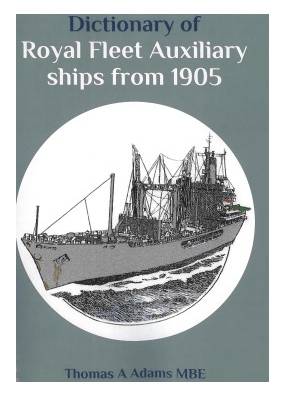A to Z of RFA ships
Dictionary of Royal Fleet Auxiliary ships from 1905, by Thomas A Adams
 This seminal publication has recently received its first update in 50 years, and it's a great opportunity to reflect on the ships and people who have served in the Royal Fleet Auxiliary (RFA) during a period of transformation. What we see today is a modern, fully-integrated element of the Royal Navy – the civilian arm which 'supports frontline global operations while delivering niche defence for UK Defence'.
This seminal publication has recently received its first update in 50 years, and it's a great opportunity to reflect on the ships and people who have served in the Royal Fleet Auxiliary (RFA) during a period of transformation. What we see today is a modern, fully-integrated element of the Royal Navy – the civilian arm which 'supports frontline global operations while delivering niche defence for UK Defence'.
Over 50 classes of RFA vessels, 430 individual vessels and 17 projected vessels get a ship-by-ship overview with their backstory, procurement, characteristics and heritage – all illustrated with black-and-white photos. There is also an appendix of vessels 'incorrectly known as RFA ships'.
And if this book whets your appetite to find out even more about RFA ships and their crews, don't forget to look at our News and Ships of the past sections of the Nautilus website.
Dictionary of Royal Fleet Auxiliary ships from 1905
By Thomas A. Adams
Whittles Publishing, £35
ISBN: 978 18499 55751
Buy this book in the Nautilus Bookshop
While you're there, why not browse the rest of the titles in our unique maritime bookshop, which sells all the books reviewed on these pages.
Buy nowMore Books
The precarious path from piracy to prosperity
The Resurrected Pirate, by Craig S ChapmanThe Resurrected Pirate is a remarkable story told in an engaging way, illustrating for the modern reader the desperately narrow passage between life and death that a seafarer in this period might have to navigate.
Carving out a career
Ships' Figureheads: Famous Carving FamiliesThe decoration of ships with figureheads was a way to present the might of military and mercantile power for centuries. These days, the skills needed to make these sculptures are kept alive by experts such as Andrew Peters, who has worked on restoration projects such as the Cutty Sark tea clipper.
Knotty problems solved
The Knot Bible: The Complete Guide to Knots And Their Uses by Nic ComptonKnot-tying is a vital competency skill for seafarers, and this expanded edition of The Knot Bible by Nic Compton offers guidance on over 200 knots and their practical uses.
Why it's nice to splice
Splicing modern ropes, 2nd edition: a practical handbook by Jan-Willem PolmanSplicing rope is as an essential skill for seafarers as tying a knot, but some skills are disappearing. This definitive guide on why splicing gets more from your rope is a great stocking filler for all boaters, whether recreational or commercial.
